- home
- BAKERECIPES
BakeRecipes
Bringing real baking into your home with deliciously simple recipes.

Prep 40min (+1.5hr chilling and 20min standing time)Bake 18-22min (per batch)Makes about 40
These delicious biscuits get their name from the pepper that, along with the ginger, gives them their "warming" flavour. I’ve made these as reindeer, but you can make them any shape you wish. Also, have fun experimenting with the icing decoration, giving them your own creative touch.
Ingredients
150g (5¼oz) unsalted butter, softened
150g (5¼oz/¾ cup, lightly packed) brown sugar
2 tablespoons golden syrup
2 tablespoons treacle
1 egg yolk, chilled
450g (3 cups/15¾oz) plain flour
2 teaspoons ground ginger
1 teaspoon ground cinnamon
½ teaspoon ground cardamom
½ teaspoon ground cloves
¼ teaspoon finely ground black pepper
½ teaspoon baking powder
½ teaspoon bicarbonate of soda
60ml (¼ cup/2fl oz) milk
Icing
375g (3 cups/13¼oz) pure icing sugar
2-3 tablespoons (40-60ml/1⅓fl oz-2fl oz) water
Method
- Use an electric mixer to beat the butter and sugar until just pale and creamy. Add the golden syrup, treacle and egg yolk and beat to combine.
- Sift together the flour, ginger, cinnamon, cardamom, cloves, pepper, baking powder and bicarbonate of soda. Add half the flour to the butter mixture and beat on lowest possible speed until just combined. Mix in the milk and then the remaining flour until just combined and a soft dough forms.
- Divide the dough into 4 portions. Shape each into a disc, wrap in plastic wrap and place in the fridge for 1 hour or until firm enough to roll.
- Preheat the oven to 170°C/340°F (150°C/300°F fan-forced). Line 3 large oven trays with non-stick baking paper.
- Use a lightly floured rolling pin to roll out one portion of dough on a lightly floured surface until 3mm/⅛in thick.
- Use a cutter/s of your choice to cut out shapes from the rolled dough and use a palette knife to carefully transfer to a lined tray, leaving a little room between each. Repeat with the remaining dough portions, rerolling any leftover dough. Place the trays of biscuits in the fridge for 30 minutes to chill.
- Bake two trays of biscuits in preheated oven for 18-22 minutes, swapping the trays halfway through baking, or until they start to colour around the edges and are cooked through. Cool on the trays. Bake the remaining tray of biscuits as before.
- To make the icing, sift the icing sugar into a medium bowl. Gradually add 2 tablespoons (40ml/1⅓fl oz) of the water and mix until smooth. The icing should be a piping consistency (see Baker’s Tips). If it's too thick, stir in the remaining water ½ tsp at a time until the icing reaches the correct consistency. Divide the icing between two resealable plastic bags, seal and then cut a small hole in one of the corners of each to pipe through.
- Use the icing to decorate the cooled biscuits as desired. Set aside for about 20 minutes or until the icing sets before serving or storing.
Baker's Tips
- To test if the icing is the correct consistency for piping, drizzle a little on a plate and set aside for a few minutes. If it keeps its shape, it's ready.
- These biscuits are lovely iced with a lemon icing. Replace the water in the icing with strained fresh lemon juice.
- These biscuits will keep in an airtight container or jar at room temperature for up to 1 week.
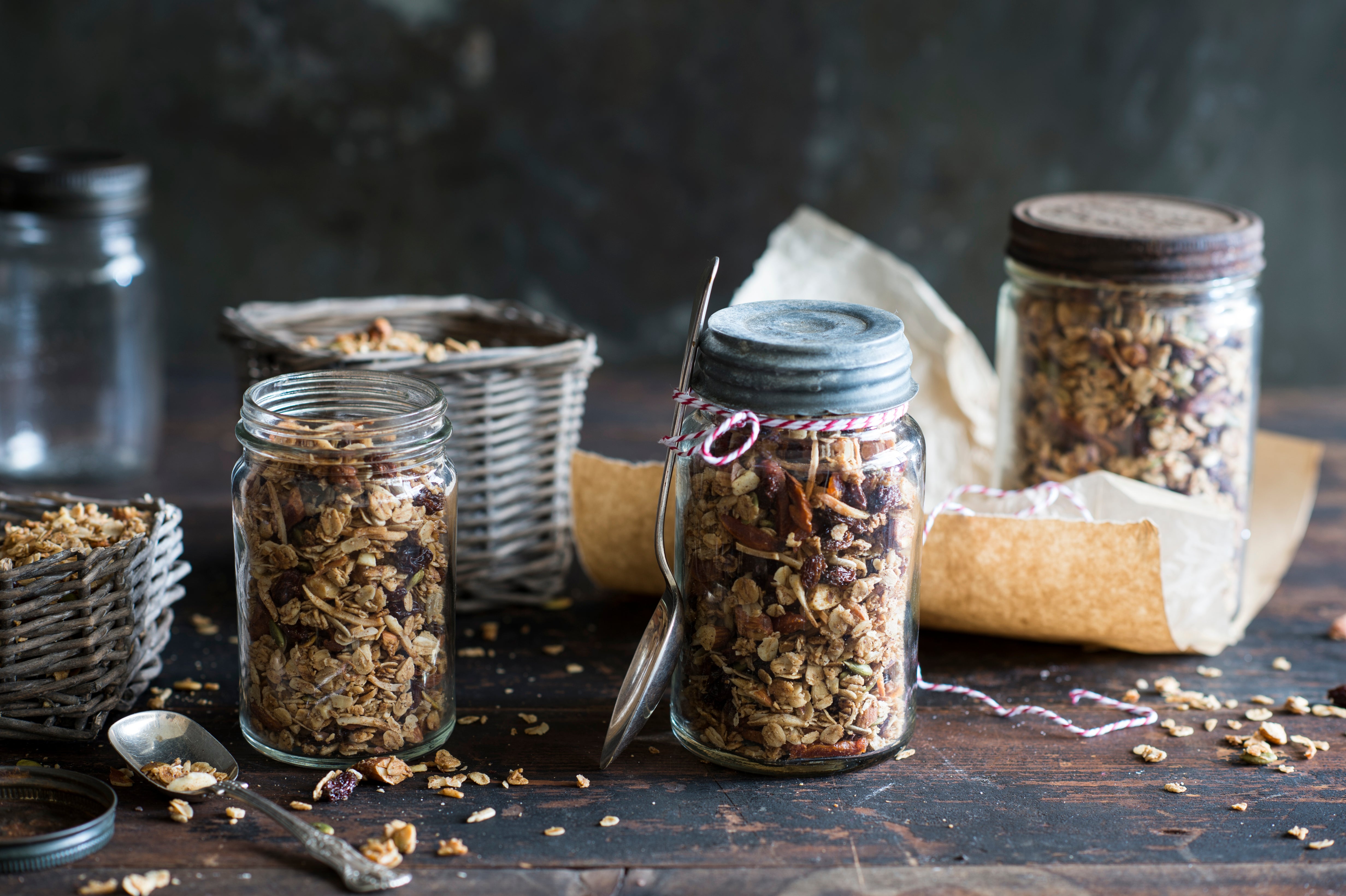
Prep 15min (+30min cooling time)Bake 40minMakes 7 cups
There really is nothing like a homemade cereal. One word of advice though – don’t leave the cardamom out as it gives this granola an elusive and fascinating flavour.
Ingredients
285g (3 cups) rolled oats
150g natural almonds, coarsely chopped
55g (¾ cup) shredded coconut
40g (¼ cup) sunflower seeds
40g (¼ cup) pepitas (pumpkin seeds)
2 teaspoons ground cinnamon
½ teaspoon ground cardamom
185ml (¾ cup) maple syrup
2 tablespoons sunflower oil
2 teaspoons vanilla essence
170g (1 cup) seedless raisins
80g (½ cup) dried apricots, shredded
Method
- Preheat oven to 160°C (140°C fan-forced).
- Line a large baking tray with non-stick baking paper.
- Combine the oats, almonds, coconut, sunflower seeds, pepitas, cinnamon and cardamom in a large heatproof bowl.
- Combine the maple syrup, sunflower oil and vanilla. Add to the oat mixture and use a wooden spoon to mix until evenly combined. Spread over the lined tray and bake in preheated oven for 30 minutes, stirring twice during baking. Stir through the raisins and apricots and bake for a further 10 minutes or until the oats are deep golden and well toasted.
- Cool on the tray (this will take about 30 minutes). Serve with milk, yoghurt and/or fruit.
Baker's Tips
- Store this granola in an airtight container in a cool dark spot for up to 1 month.
This recipe is from Anneka's SBS Food online column, Bakeproof: Gifts from the Kitchen. CLICK HERE for more Bakeproof recipes.
Photography by Alan Benson.
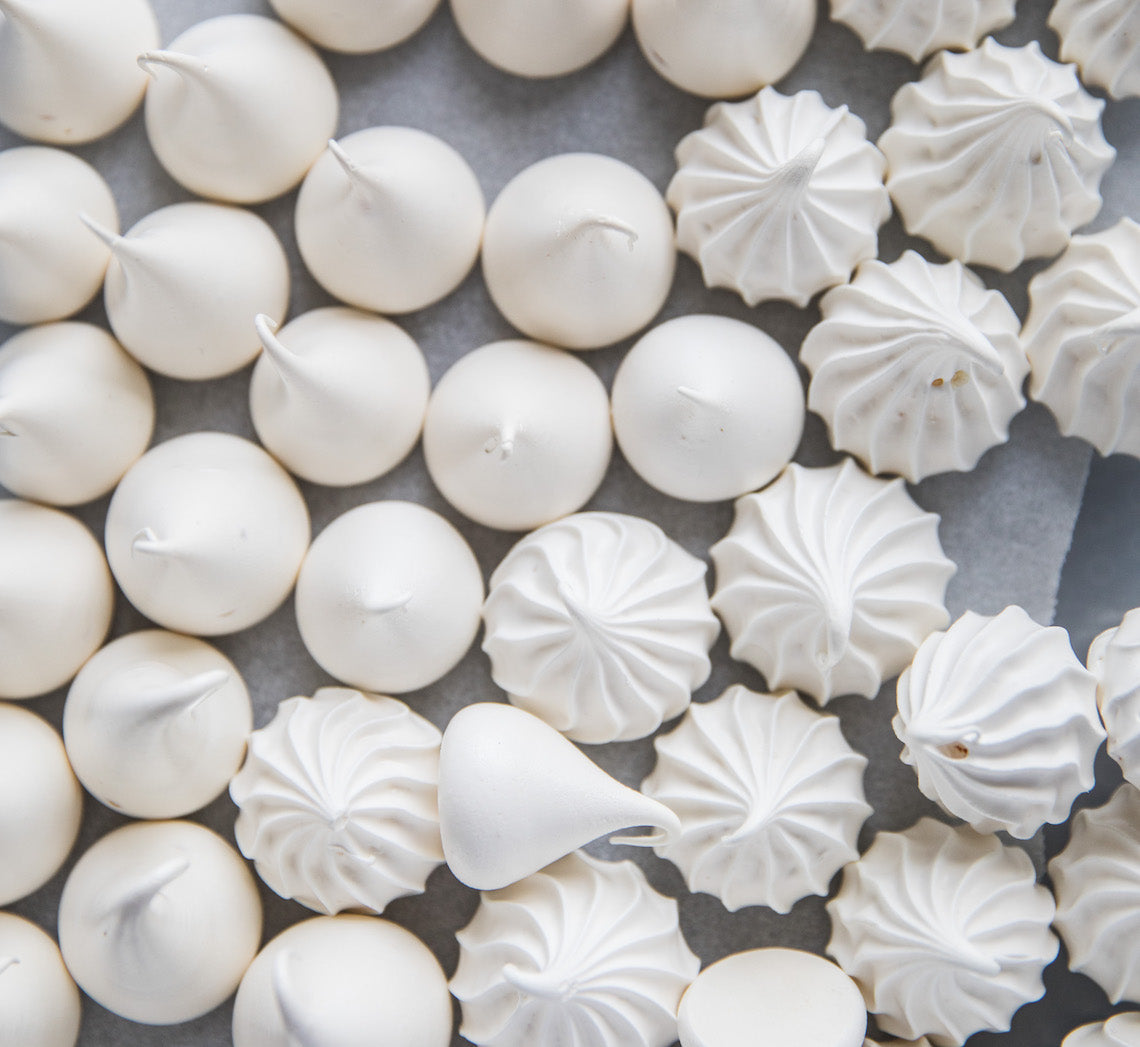
Prep 40min (+1-2hr cooling time)Bake 1hr-1hr10minMakes about 50
Ingredients
2 egg whites (from 60g/2oz eggs)
110g (½ cup/4oz) caster sugar
1 teaspoon natural vanilla essence or extract
2 teaspoons gluten-free cornflour, sifted
Method
- Preheat oven to 110°C/230°F (90°C/195°F fan-forced). Line an oven tray with non-stick baking paper.
- Combine the egg whites and sugar in a medium heatproof bowl (preferably metal) and place over a saucepan of simmering water, ensuring the bowl doesn’t touch the water. Stir with a spatula or small whisk until the sugar dissolves and the mixture is hot to touch (about 55-60°C on a sugar thermometer). Be careful not to allow the egg whites to cook.
- Transfer the egg white mixture to the bowl of an electric mixer (see Baker’s Tips). Whisk the egg white mixture with a whisk attachment on medium-high speed until very thick and glossy and the mixture has cooled to room temperature. Whisk in the vanilla and cornflour.
- Fill a large piping bag fitted with a 4B star (or #11/11mm/½in round) piping nozzle with the meringue mixture. Holding the piping nozzle about 1cm/½in above the tray, pipe small rosettes (or 'kisses') about 2.5cm/1in in diameter and 2cm apart on the lined tray.
- Bake in a preheated oven for 60-70 minutes or until the meringues are crisp, hard to touch and peel away from the tray easily, but are not coloured.
- Remove the meringues from the oven and place immediately in an airtight container lined with absorbent paper
Variations
- Striped Meringue Kisses: Use a paintbrush to lightly brush evenly spaced vertical lines of food colouring gel on the inside of the large piping bag before spooning the meringue mixture into the piping bag. Continue as per the recipe.
Baker's Tips
- The fan-forced setting is often too intense for baking meringues and will cause them to crack. If this is the case with your oven, opt for the conventional setting. However, if the meringues do crack when using the convention setting, your oven may be running a little hot and next time reduce the temperature by 5-10°C (41-50°F) as this will often help prevent them from cracking.
- If you don't have a small bowl for your mixer, first whisk the egg white mixture with a balloon whisk until it is foamy and doubled in volume before whisking with the stand mixer. This will make the whisking of the egg white mixture more efficient in a standard size bowl.
- Allowing the egg white mixture to come to room temperature before whisking will reduce the time it will take to whisk it to a meringue.
- These meringues will keep in an airtight container at room temperature for up to 1 week.

Prep 30min (+15min cooling and 1hr standing time)Bake 15minMakes 20
The German word spritzen means to squirt and reflects the way these cookies are shaped – by pushing them through a piping nozzle. The almond meal in the dough gives a lovely soft, almost cakey, texture to these chocolate-dipped cookies that can be piped in various designs, including mini wreaths.
Ingredients
- 250g butter, softened
- 220g (1 cup) caster sugar
- 1½ teaspoon natural vanilla essence or extract
- 3 eggs
- 450g (3 cups) plain flour
- 60g almond meal
- 300g good-quality dark chocolate (45-54% cocoa), chopped
Method
- Preheat oven to 180°C (160°C fan-forced). Line two large oven trays with non-stick baking paper.
- Use an electric mixer to beat the butter, sugar and vanilla until pale and creamy. Add the eggs, one at a time, beating well between each addition. Combine the flour and almond meal. Add to the butter mixture and beat on the lowest possible speed until just combined.
- Spoon half the mixture into a large piping bag fitted with a 13 mm (#13) star nozzle. Pipe 6–7 cm circles onto the lined trays (see Baker’s tips). Repeat with the remaining mixture.
- Bake for 15-18 minutes, swapping the trays halfway through baking, or until pale golden and cooked through. Cool on the trays.
- Place the chocolate in a heatproof bowl over a saucepan of simmering water and heat, stirring occasionally, until melted. Turn off the heat but leave the bowl sitting on top. Dip a cooled cookie into the chocolate to coat half of the cookie. Place back on the lined tray and repeat with the remaining cookies. Tap the trays on the benchtop lightly to settle the chocolate into the grooves of the cookies, then set aside for about 1 hour or until the chocolate sets.
Baker's tips
- You can use a 6–7 cm round cutter as a guide to draw circles onto the underside of the baking paper to help keep your cookies uniform in size.
- These cookies will keep in an airtight container at room temperature for up to 1 week.
This recipe is from Anneka's SBS Food online column, Bakeproof: Festive Cookies.
CLICK HERE for more Bakeproof columns and recipes.
Photography by China Squirrel.
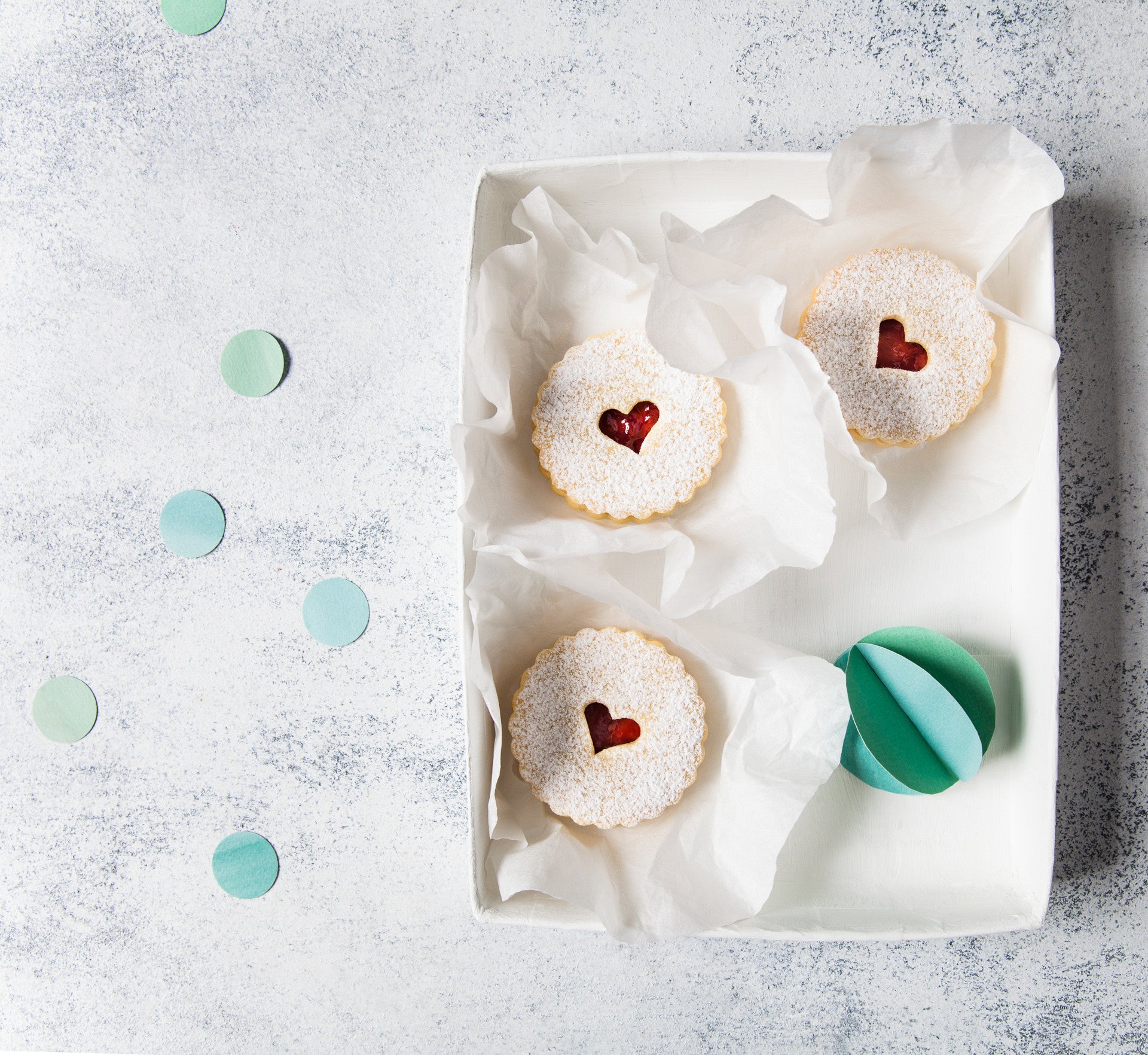
Prep 30min (+ 15min cooling and 30min chilling time)Bake 25-30minMakes about 15
These jammy, Linzer-like, buttery mouthfuls are a popular inclusion in the German Weihnachtsplätzchen (collection of traditional festive cookies) but are often claimed by the Swiss. Feel free to switch up the type of jam you use – red currant is also very traditional.
Ingredients
185g (6½oz) salted butter, at room temperature
110g (½ cup/4oz) caster sugar
1 teaspoon natural vanilla essence or extract
1 egg yolk
300g (2 cups/11¾oz) plain flour
¼ teaspoon fine salt
110g (⅓ cup/4oz) raspberry jam, warmed slightly
Icing sugar, to dust
Method
- Preheat oven to 160°C/315°F (140°C/285°F fan-forced). Line two large oven trays with non-stick baking paper.
- Use an electric mixer with a paddle attachment to beat the butter, sugar and vanilla until pale and creamy. Add the egg yolk and beat well. Sift together the flour and salt. Add to the butter mixture and beat on lowest possible speed until just combined and a soft dough forms.
- Divide the dough in half. Use a rolling pin to roll out one portion of dough between two sheets of non-stick baking paper to 5mm/¼in thick. Use a 6cm/2¼in fluted round cutter to cut out rounds of dough. Use a palette knife to transfer the rounds to the lined trays, leaving about 2cm/¾i between each to allow for spreading. Repeat with the remaining dough portion, re-rolling off-cuts, to make about 30 rounds in total. Place the trays in the fridge for 30 minutes to chill.
- Use a 2cm/¾in heart, fluted round or star-shaped cutter to cut the centre from half of the chilled cookie rounds.
- Bake for 25-30 minutes, swapping the trays halfway through baking, or until pale golden and cooked through. Cool on the trays.
- Spoon 1 teaspoon of the warm jam onto each of the cookie bases and spread to about 1cm/½in from the edge. Dust the cookie tops (with the cut-outs) generously with icing sugar. Carefully sandwich the cookies together, pressing gently to join.
Baker's Tip
- These cookies will keep in an airtight container, layered with baking paper, at room temperature for up to 1 week. Dust with icing sugar again if desired before serving.
This recipe is part of Anneka's SBS Food Bakeproof: Festive Cookies online column. For more Bakeproof columns and recipes, click here.
Photography by China Squirrel.
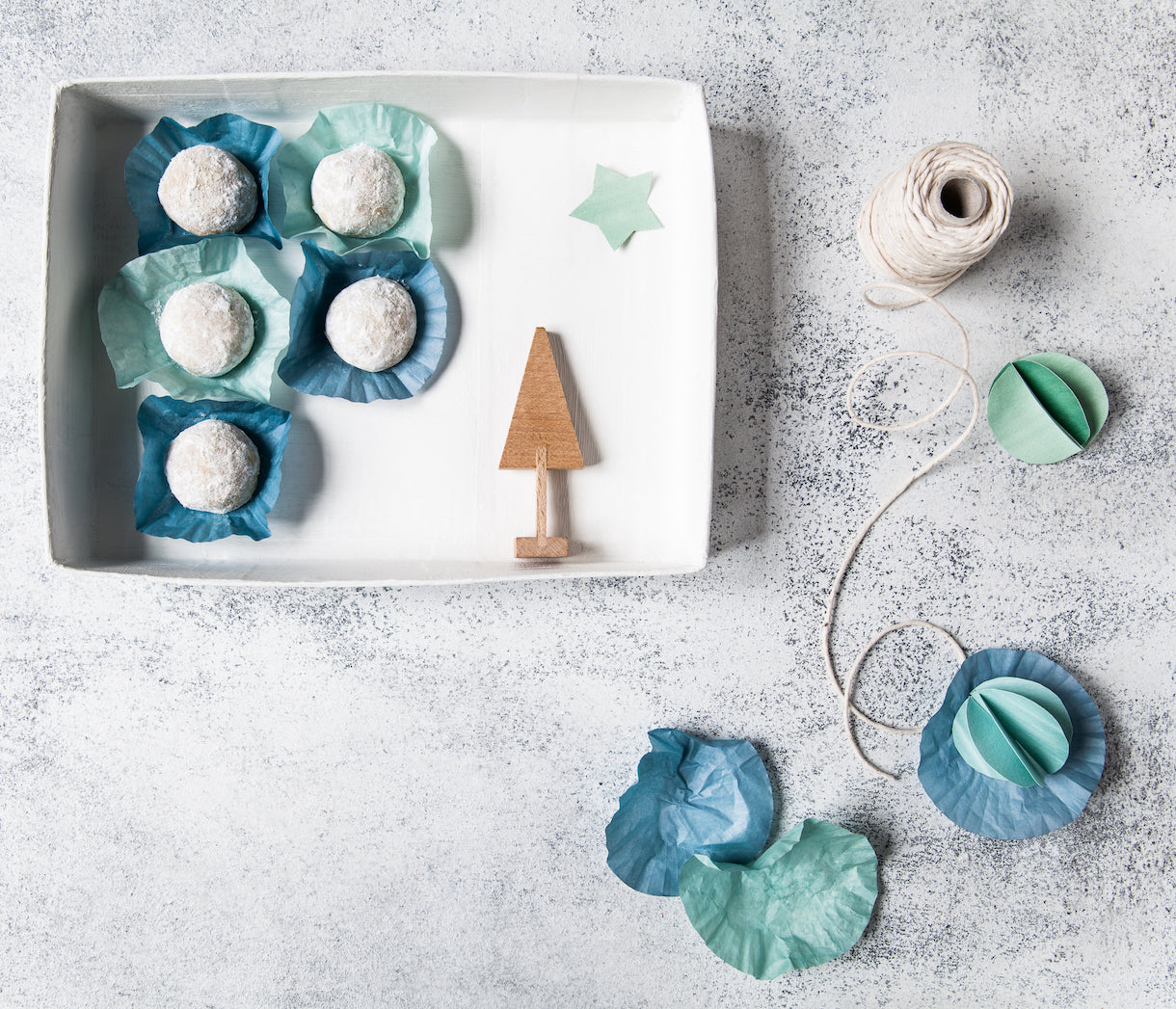
Prep 30min (+20min cooling time)Bake 15minMakes about 50
Often associated with Christmas in Germany, these bite-sized mouthfuls of gingerbread deliciousness actually originated in Scandinavia. The combination of a soft, highly spiced centre hidden beneath a crisp, sugar-powdered outer coat is pure, festive heaven.
Ingredients
125g (4½oz) unsalted butter, softened slightly
110g (½ cup, firmly packed/4oz) dark brown sugar
1 lemon, zest finely grated
1 orange, zest finely grated
90g (¼ cup/3oz) honey
1 egg, at room temperature
40g (¼ cup/1½oz) finely chopped candied citrus rind / mixed peel
350g (2⅓ cups/12¼oz) plain flour
½ teaspoon baking powder
½ teaspoon bicarbonate of soda
2 teaspoon ground cinnamon
½ teaspoon ground black pepper
½ teaspoon ground ginger
¼ teaspoon crushed aniseed
½ teaspoon ground nutmeg
¼ teaspoon ground cloves
¼ teaspoon ground allspice
125g (1 cup/4½oz) pure icing sugar, to dust
Method
- Preheat oven to 160°C/315°F (140°C/285°F fan-forced). Line two large oven trays with non-stick baking paper.
- Use an electric mixer with a paddle beater to beat the butter, sugar and citrus zest until just creamy. Add the honey and beat until just combined. Add the egg and beat until evenly combine. Mix in the candied citrus rind / mixed peel.
- Sift together the flour, baking powder, bicarbonate of soda and spices. Add the flour mixture to the butter mixture and beat on lowest possible speed until just combined and a soft dough forms.
- Roll heaped teaspoonfuls of the mixture into balls and place 5cm/2in apart on the lined trays. Bake in preheated oven for 10-12 minutes, swapping the trays halfway through baking, or until they start to crack and are just cooked through.
- Sift the icing sugar into a medium bowl. Add about 6 warm biscuits to the icing sugar and toss to coat generously. Place on a wire rack to cool and repeat with the remaining biscuits.
Baker's Tips
- The uncooked dough will keep covered in the fridge for up to 2 days. Roll and bake straight from the fridge.
- These biscuits will keep in an airtight container at room temperature for up to 1 month.
- Dust with icing sugar again just before serving if desired.
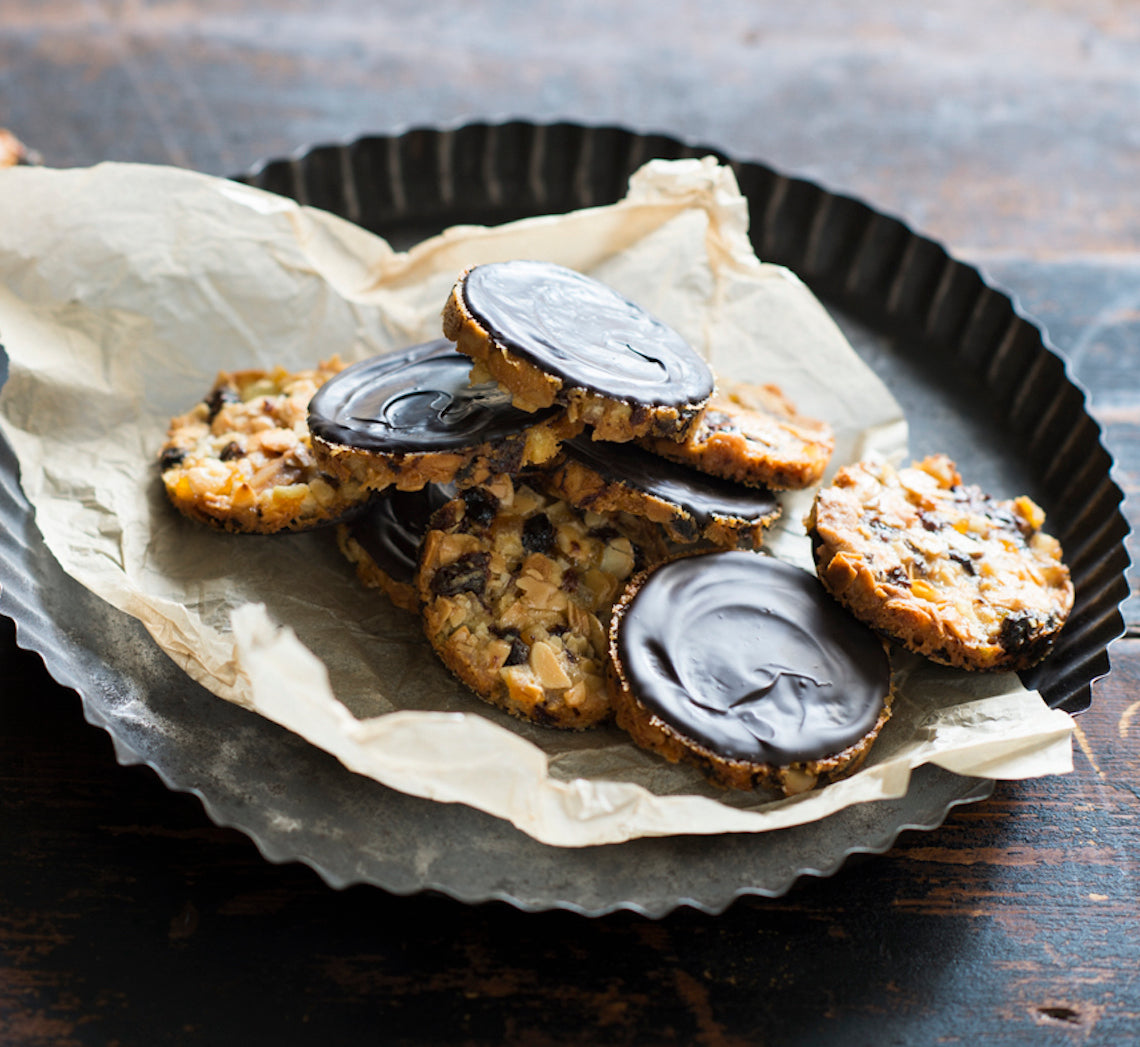
Prep 20minBake 25min(per batch)Makes about 24
Often attributed to the Italians, it is believed that Florentines were actually created in the royal French kitchens in the late 1600s in honour of their Tuscan in-laws, hence their name. Admittedly a little confusing for us, but incredibly flattering for the in-laws!
Ingredients
Melted butter, to grease
200g flaked almonds
150g sour dried cherries, finely chopped
150g candied orange rind, finely chopped
75g (½ cup) plain flour
75g butter, cubed
75g (⅓ cup) caster sugar
115g (80ml/⅓ cup) honey
200g good-quality dark chocolate (70% cocoa), melted and cooled (see Baker's Tips)
Method
- Preheat oven to 160°C (140°C fan-forced).
- Line an oven tray with non-stick baking paper. Brush the inside of six 7.5cm metal egg rings (see Baker's Tips) with a little melted butter to grease and place on the lined oven tray.
- Combine the flaked almonds, dried cherries, candied orange rind and flour in a large bowl and stir to combine evenly. Combine the butter, sugar and honey in a small saucepan and stir over medium heat until the butter just melts and the mixture is well combined. Add to the almond mixture and stir gently with a large metal spoon or spatula until evenly combined.
- Spoon 1½ tablespoons of the mixture into an egg ring to fill half way and use the back of a metal spoon to spread, leaving it a little uneven if you want. Repeat with more mixture and the remaining five egg rings.
- Bake in preheated oven for 25 minutes or until golden and cooked through. Remove from the oven and cool on the trays for 5 minutes before removing the egg rings. Grease the egg rings again with a little more melted butter and repeat with the remaining mixture in three more batches.
- Use a palette knife or the back of a teaspoon to spread a generous amount of melted chocolate over the underside of a florentine to cover. Place on a wire rack, chocolate side up and set aside for 1 hour or until the chocolate sets. Repeat with the remaining cooled florentines.
Baker's Tips
- The longer the chocolate cools the thicker it will become and the more defined the 'swirls' of chocolate will be.
- Non-stick egg rings are perfect to use to make these florentines, but they will still need to be greased.
- These florentines will keep in an airtight container or jar in a cool dark place for up to 2 weeks.
This recipe is from Anneka's SBS Food online column, Bakeproof: Gifts from the Kitchen. CLICK HERE for more Bakeproof recipes.
Photography by Alan Benson.

Prep 30min (+2hr cooling time)Bake 40-45minMakes about 20-24 pieces
Hailing from Siena in the Tuscan region of Italy, panforte (‘strong bread’ when translated to English) is a delectable combination of dried fruits, nuts, spices, honey and, if you are lucky, chocolate. It is believed to date back to the 13th Century and was originally a form of tax paid to a local monastery. Like many traditional recipes, there are many variations with each often being a well-guarded family recipe – however I will share this one with you!
Ingredients
- Melted butter, to grease
- 2 sheets confectioner's rice paper (see Baker's Tips)
- 75g (½ cup/2¾oz) plain flour
- 40g (⅓ cup/1½oz) cocoa powder
- 1 teaspoon ground cinnamon
- ½ teaspoon freshly ground black pepper
- 70g (½ cup/2½oz) dried pitted dates, coarsely chopped
- 80g (½ cup/2¾oz) prunes, coarsely chopped
- 80g (2¾oz) glace apricots, chopped
- 155g (1 cup/5½oz) unsalted roasted macadamias, coarsely chopped
- 160g (1 cup/5¾oz) blanched almonds, coarsely chopped
- 70g (½ cup/2½oz) unsalted pistachio kernels
- 100g (3½oz) good-quality dark chocolate, chopped
- 1½ tablespoon finely grated orange rind
- 175g (½ cup/6¼oz) honey
- 110g (½ cup/4oz) caster sugar
- 2 tablespoon water
- 1 teaspoon natural vanilla essence or extract
- Icing sugar or extra cocoa powder, to dust
Method
- Preheat oven to 170°C/340°F (150°C/300°F fan-forced).
- Brush a shallow round 20cm/8in (base measurement) tin with melted butter to grease and then line the base with a circle of rice paper, cutting the sheets to fit. Line the sides with a strip of non-stick baking paper.
- Sift the flour, cocoa and spices into a large bowl, then stir in the fruit, nuts, chocolate and orange rind. Set the bowl on a folded tea towel (see Baker's Tips).
- Put the honey, sugar and water in a small saucepan. Stir over low heat, without boiling, until the sugar dissolves. Bring to the boil and simmer, uncovered and without stirring, for 5 minutes. Immediately pour the hot syrup and vanilla over the fruit and nut mixture and, working quickly, stir with a wooden spoon until well combined. Press mixture firmly and evenly into prepared tin.
- Bake for 40-45 minutes or until firm to touch in the centre. Cool in the pan sitting on a wire rack (this will take about 2 hours).
- Remove from pan and dust liberally with icing sugar or cocoa. Serve in thin slices or wedges.
Baker's Tips
- Confectioner's rice paper sheets are available from Asian grocers, delicatessens and specialty food stores. Don't confuse it with Asian rice paper, used to make rice paper rolls.
- Before adding the hot syrup to the fruit and nut mixture, place a tea towel under the bowl to stop it from slipping when mixing.
- To make individual panforte, grease eight 8cm (base diameter) loose-bottomed tart tins with oil spray or melted butter and line the bases with a circle of edible rice paper. Divide the mixture among the tins and press down firmly. Bake for 25-30 minutes.
- This panforte will keep wrapped well in plastic wrap at room temperature in a cool spot for up to 1 month.
This recipe is from Anneka's SBS Food online column, Bakeproof: Gifts from the Kitchen.
CLICK HERE for more Bakeproof recipes.
Photography by Alan Benson.
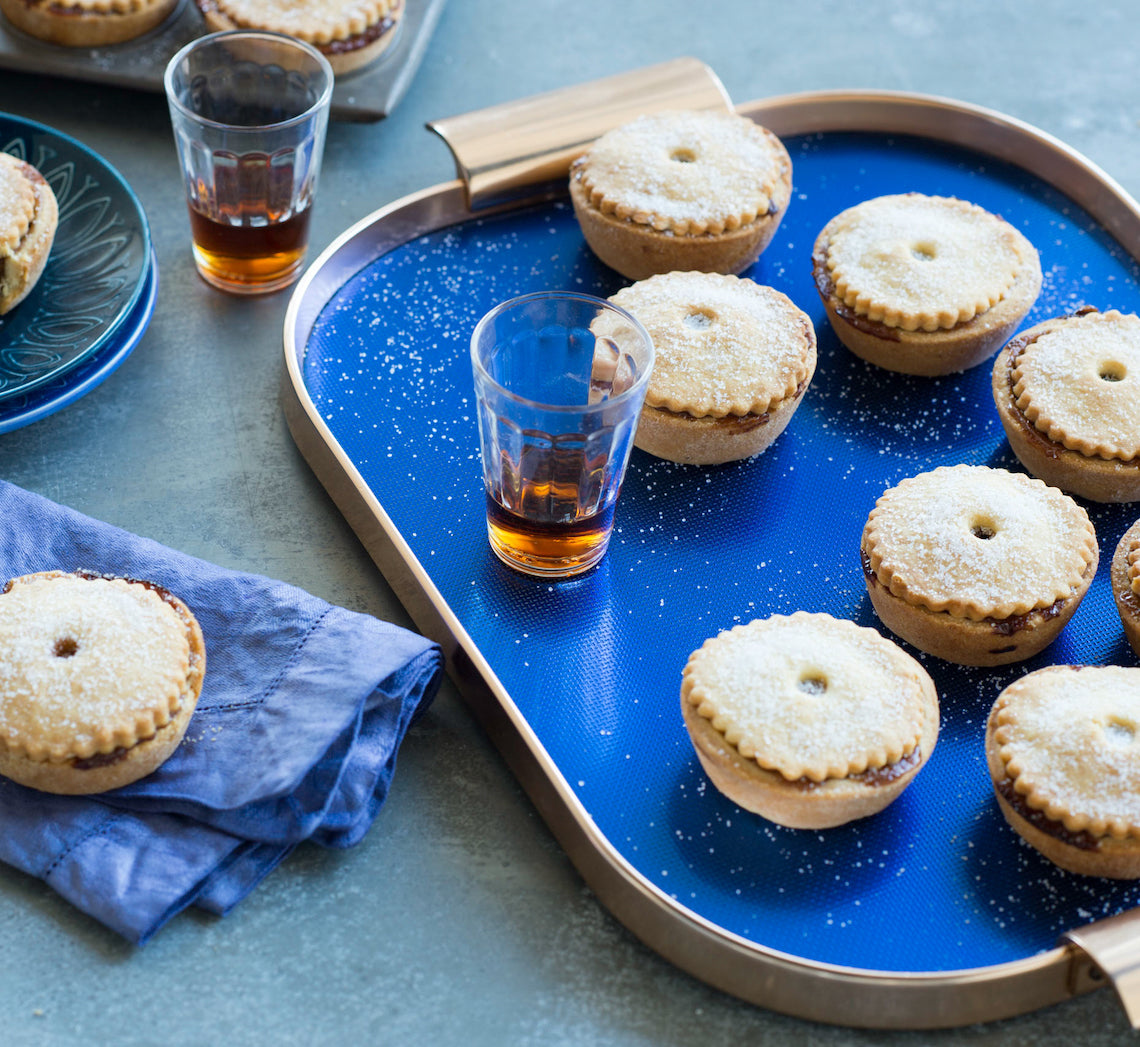
Prep 50min (+20min chilling and 50min cooling time)Bake 35minMakes about 20
According to a Middle Ages custom, if you eat a mince pie every day from Christmas day until Twelfth Night (6 January) you will have happiness for the whole year – what a wonderful excuse to indulge in these spiced, fruit-filled pies. Eat them at room temperature or straight from the oven with ice-cream, cream or brandy sauce.
You will need two 12-hole 80 ml (⅓ cup) muffin tins for this recipe.
Ingredients
Granulated sugar, to sprinkle
Fruit mince
2 small (about 150g each) Granny Smith apples, peeled, cored and coarsely grated
130 g (¾ cup) sultanas
115g (¾ cup) currants
130g (¾ cup) seedless raisins
75g (½ cup) mixed peel or chopped glace apricots
50g (⅓ cup) chopped blanched almonds
125ml (½ cup) brandy or apple cider
1 orange, zest finely grated and juiced
1 lemon, zest finely grated and juiced
2 teaspoons mixed spice
½ teaspoon ground ginger
¼ teaspoon ground cloves
100g (½ cup, loosely packed) dark brown sugar
60g unsalted butter, coarsely grated
Sweet shortcrust pastry
600g (4 cups) plain flour
125g (1 cup) icing sugar, sifted
1 teaspoon baking powder
½ teaspoon salt
300g chilled unsalted butter, diced
2 egg yolks
80-100ml iced water
Method
- To make the fruit mince, combine the grated apple, dried fruit, mixed peel, almonds, brandy or cider, orange and lemon zest and juice, and the spices in a medium saucepan. Cook over low heat, stirring occasionally for 20 minutes or until the excess liquid has evaporated. Remove from heat and set aside for 40 minutes or until cooled to room temperature.
- Meanwhile, to make the pastry, place the flour, icing sugar, baking powder and salt in a medium mixing bowl. Add the chilled butter. With your palms facing upwards, use your fingertips to rub in the butter until the mixture resembles coarse breadcrumbs. Use a fork to whisk together the egg yolks and 80 ml (⅓ cup) of the iced water and then sprinkle over the flour and butter mixture. Use a round-bladed knife in a cutting motion to mix until evenly combined and the mixture starts holding together. Press a little of the mixture between your fingers: if it holds together easily, there is no need to add more water. If it doesn’t, add the remaining 1 tbsp (20 ml) water and combine. The pastry should be soft but not sticky. Bring the pastry together with your hands and transfer to a lightly floured, cool bench top. Lightly knead the pastry with your fingertips for about 30 seconds or until smooth and soft. Divide pastry into three portions. Shape each into a disc, wrap separately in plastic wrap and place in the fridge for 20 minutes to rest.
- Preheat oven to 190°C (170°C fan-forced). Stir the sugar and butter through the cooled fruit mince.
- Use a lightly floured rolling pin to roll out one portion of the pastry to 3 mm thick. Use a 9 cm plain round cutter to cut out 10 rounds, re-rolling the offcuts if needed and line 10 x 80ml (⅓ cup) muffin tin holes, pressing into the sides and base with your fingertips (the pastry won’t reach to the top of the holes). Repeat with another portion of pastry to make another 10 pastry shells. Divide the fruit mince evenly among the pastry shells. Roll out the remaining pastry portion until 5 mm thick and use a 6.5 cm fluted round cutter to make the pie tops, re-rolling the off-cuts if needed. Use the end of a 7 mm piping nozzle to cut out a circle in the centre of each lid. Place a lid on top of each pie, and use your fingertips to gently ease the pastry out to meet the pastry case bases. Sprinkle each pie with a little granulated sugar.
- Bake in preheated oven for 35 minutes or until the pastry is deep golden and cooked through. Remove from the oven and stand in the tin for 10 minutes to cool slightly before transferring to a wire rack. Serve warm or at room temperature. Sprinkle with a little more granulated sugar, if desired.
Baker's Tips
- These pies will keep in an airtight container at room temperature for up to 1 week.
- To reheat, place the pies back in the muffin holes and place in an oven preheated to 170°C (150°C fan-forced) for 10-15 minutes or until heated through.
This recipe is from Anneka's SBS Food online column, Bakeproof: Traditional Christmas Baking. CLICK HERE for more Bakeproof recipes.
Photography by Alan Benson.

Prep 40min (+ 30min cooling time)Bake 25-30minMakes about 24
Originating in Vienna, Austria, these vanilla sugar-coated biscuits are traditionally shaped like a ‘kipfler’ or horseshoe. While they’re a Christmas favourite, they’re also popular across Eastern Europe – including Germany, Hungary, Slovakia, Romania and the Czech Republic – and closely resemble the well-known Greek Kourabiedes. Buttery and almond-rich, they make a lovely gift.
Ingredients
185g (6½oz) unsalted butter
60g (½ cup/2oz) icing sugar mixture, plus 60g (½ cup/2oz) extra to coat
1 teaspoon natural vanilla essence, extract or bean paste
2 egg yolks
225g (1½ cups/8oz) plain flour
50g (½ cup/1¾oz) almond meal
1 vanilla bean
Method
- Preheat oven to 160°C/315°F (140°C/285°F). Line two large oven trays with non-stick baking paper.
- Use an electric mixer to beat the butter, icing sugar mixture and vanilla until pale and creamy. Add the egg yolks and beat until well combined.
- Combine the flour and almond meal, add to the butter mixture and beat on lowest possible speed until just combined and a dough forms.
- Shape level tablespoonfuls of the mixture into small logs about 6cm ( 2¼in) long and then taper the ends and shape into a crescent shape. Place on the lined trays about 2cm ( ¾in) apart. Bake in preheated oven for 25-30 minutes or until pale golden and cooked through.
- Meanwhile, halve the vanilla bean lengthways, use a small sharp knife to scrape the seeds out and add to the extra icing sugar mixture in a medium bowl. Use your fingertips to rub the vanilla seeds through the icing sugar evenly.
- When the biscuits are cooked, remove from the oven and then toss while still warm, one at a time, through the vanilla icing sugar to coat (see Baker’s Tips). Cool completely on a wire rack.
Baker's Tips
- These biscuits will keep in an airtight container at room temperature for up to 1 week.
- Reserve any remaining vanilla sugar and use to sprinkle over the biscuits just before serving if you wish.
This recipe is from Anneka's SBS Food online column, Bakeproof: Traditional Christmas Baking.
CLICK HERE for more Bakeproof recipes.
Photography by Alan Benson.
Prep 30minBake 3hr45minMakes about 1 x 20cm cake
This rich fruit cake would be the perfect addition to Christmas lunch – or any other time of the year. You will need to start the day before and prepare the pan accordingly (see the link in the recipe below).
Ingredients
- 300g dried figs
- 200g pitted dates
- 300g dried cranberries
- 200g sultanas
- 200g currants
- 100g raisins
- 110g (⅓ cup) fig jam
- 185ml (¾ cup), brandy, plus 60ml (¼ cup) extra
- 180g unsalted butter, at room temperature
- 110g (½ cup, firmly packed) brown sugar
- 4 eggs, at room temperature
- 200g blanched almonds, plus extra to decorate
- 1 orange, zest finely grated and juiced
- 150g (1 cup) plain flour
- 50g (½ cup) almond meal
- 1 teaspoon baking powder
- 2 teaspoons ground cinnamon
- 1 teaspoon ground ginger
- ¼ teaspoon ground cloves
Method
- Chop figs and dates to same size as sultanas. Put in a large bowl with cranberries, sultanas, currants, raisins, jam and brandy. Cover and set aside at room temperature for at least 1 day.
- Preheat the oven to 150°C. Grease and line the base and sides of a deep square pan with removable base (20cm, top measurement). Prepare the pan for baking a rich fruit cake (Click here for instructions).
- Use an electric mixer to beat butter and sugar until pale and creamy. Add the eggs one at a time, beating well after each addition. Stir in the soaked fruit, almonds, orange juice and zest.
- Whisk together the flour, almond meal, baking powder and spices to combine evenly. Add to the fruit mixture and use a wooden spoon and then your hands to mix lightly until well combined.
- Spoon the mixture into the prepared pan and press into the corners and then smooth the surface (see Baker's Tips). Decorate with extra nuts. Cover the cake with a piece of foil. Bake in preheated oven for 1 hour. Remove the foil and continue to bake for a further 2 hours and 45 minutes or until just cooked when a skewer inserted into the centre comes out clean.
- Pour the extra brandy evenly over the top of the hot cake. Trim any overhanging paper, cover the pan well with foil and then wrap the cake, still in the tin, in two tea towels. Cool overnight.
Baker's Tips
- Before preheating your oven, position the oven rack so that the middle of the cake pan will be in the centre of the oven.
- Before baking your cake, drop the pan on the bench 4-5 times to make sure the mixture fills the corners and gets rid of any unwanted air pockets.
- This cake will keep wrapped in plastic wrap and then foil in an airtight container for up to 6 weeks. If you don't use the nuts, it will last for up to 3 months.
Prep 25min (+ 2hr chilling, cooling and standing time)Bake 12-15minMakes about 35
Based on a deliciously spiced gingerbread, these fun biscuits are given their personalities through simple decorations... Make them into cheeky gingerbread men or turn them upside down and decorate them as cute, Christmas-themed reindeer.
Ingredients
125g (4½oz) unsalted butter, softened
90g (½ cup, lightly packed/3oz) brown sugar
235g (⅔ cup/8¼oz) golden syrup
1 teaspoon natural vanilla extract or essence
375g (2½ cups/13¼oz) plain flour
2 teaspoons ground ginger
1 teaspoon ground cinnamon
1 teaspoon bicarbonate of soda
Icing
185g (1½ cups/6½oz) pure icing sugar
35ml (7 teaspoons) boiling water
Red food colouring
Method
- Use an electric mixer with a paddle attachment to beat the butter and sugar on medium speed for 2-3 minutes, or until pale and creamy. Add the golden syrup and vanilla and beat to combine. Sift together the flour, ginger, cinnamon and bicarbonate of soda. Add to the butter mixture and beat on low speed until just combined and a dough forms. Divide the dough into 2 portions. Shape each into a disc about 2cm/¾in thick, wrap in plastic wrap and place in the fridge for 2 hours to chill.
- Preheat the oven to 160ºC/315°F(140°C/285°F fan-forced). Line two large oven trays with baking paper.
- Use a lightly floured rolling pin to roll out one portion of dough (leave the remaining portion in the fridge) on a lightly floured bench top to 4mm/⅛in thick. Use an 8cm/3¼in tall gingerbread man cutter to cut out shapes and then carefully transfer the shapes to the prepared oven trays using a palette knife, leaving a little room between each for spreading. Reroll any scraps to make more shapes. Discard any off cuts from the second rolling.
- Bake in preheated oven for 12-15 minutes or until the biscuits are just starting to colour and are cooked through. Stand on the trays for a few minutes before transferring to a wire rack to cool. Repeat with the remaining gingerbread dough portion.
- To make the Icing, sift the icing sugar into a medium bowl. Gradually add 30ml (6 teaspoons) of the boiling water and mix until smooth. The icing should be a piping consistency (see Baker’s Tips). If it is too thick stir in the remaining 1 teaspoon of boiling water and then test the consistency again. Spoon ¾ of the icing into a piping bag fitted with a 3mm/⅛in nozzle (see Baker’s Tips) and set aside. Stir a couple of drops of red food colouring into the remaining icing to reach the desired colour. Spoon into a separate piping bag fitted with a 3mm/⅛in nozzle.
- Use the icing to decorate the cooled biscuits to make men and/or reindeer as desired (using the photograph as a guide). Set aside for about 20 minutes or until the icing sets completely.
Baker's Tips
- To test if the icing is the correct consistency for piping, drizzle a little off the end of a teaspoon onto a plate and set aside for a few minutes. If it keeps its shape it is ready to use.
- If you don’t have piping bags and nozzles you can spoon the icing into a snap-lock bag, seal and then cut a small hole in one of the corners to pipe through.
- Store in an airtight container at room temperature for up to 1 week.
Photography by Georgie Esdaile.






